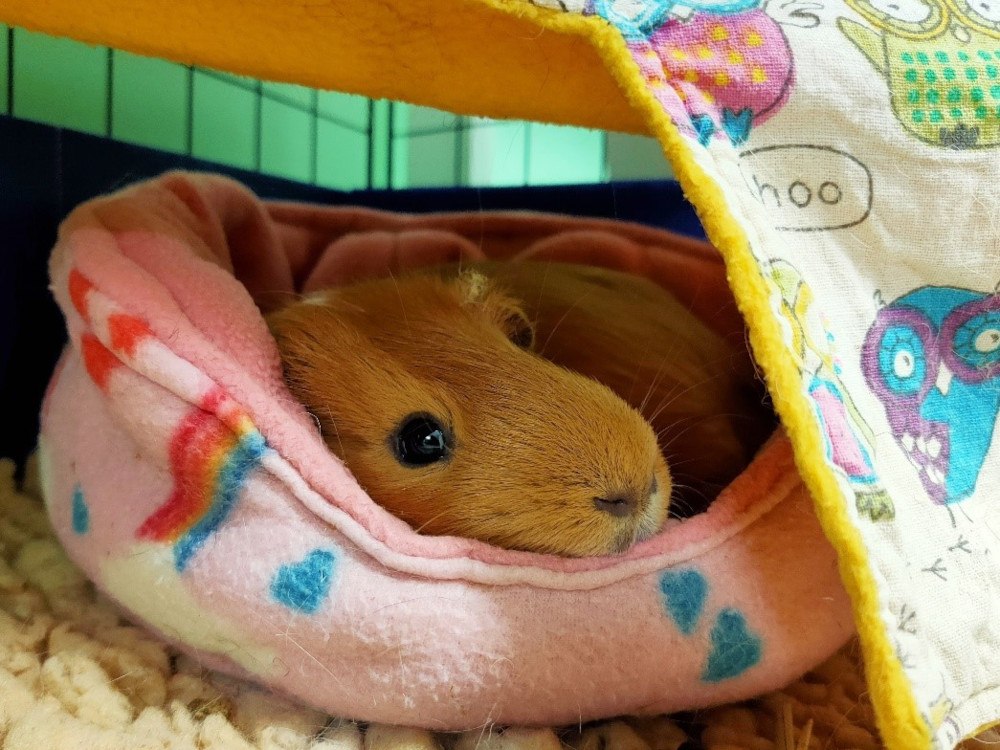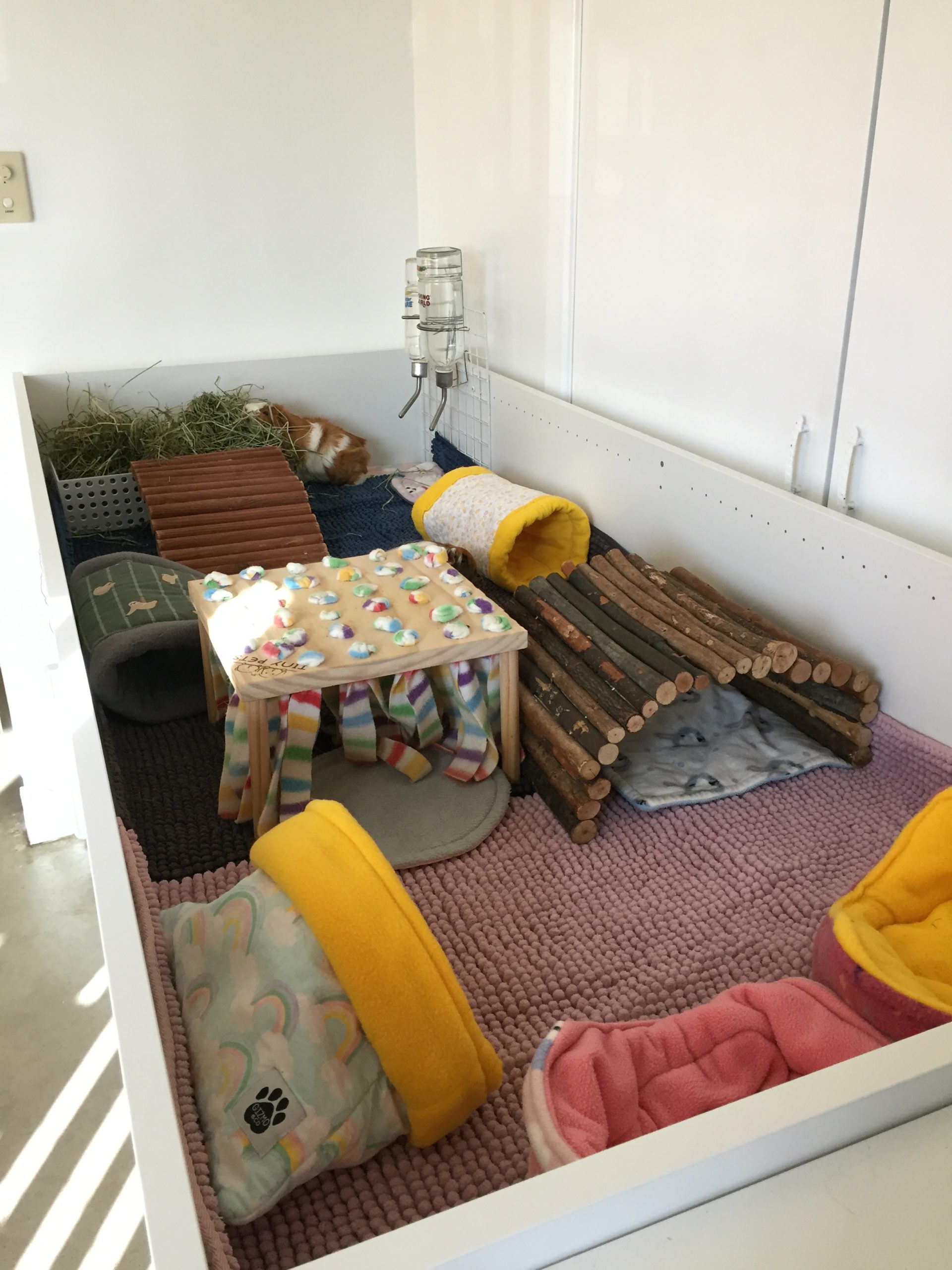To set up a guinea pig friendly living space, focus on a spacious cage, soft bedding, and engaging enrichment activities. Providing a large cage with proper ventilation, cozy bedding, and stimulating toys is essential for your guinea pig’s well-being.
This ensures they have enough room to move around, rest comfortably, and stay mentally stimulated. By following these guidelines, you can create a safe and enriching environment for your furry friend to thrive in. Remember, a happy guinea pig is a healthy guinea pig!
Contents
Creating A Safe Guinea Pig Environment
Creating a safe guinea pig environment involves following guidelines for setting up cages, choosing bedding, and providing enrichment activities. Ensure a guinea pig-friendly living space with appropriate space, bedding choices, and engaging activities to promote their well-being and happiness.
Guinea pigs are adorable and social animals that make great pets. To keep them healthy and happy, it’s essential to create a safe living space. This guide will provide you with guidelines for setting up and maintaining a guinea pig-friendly environment. In this section, we’ll focus on creating a safe guinea pig environment. We’ll discuss the right cage size, materials to avoid, and enrichment activities.
Choosing The Right Cage Size
Guinea pigs require ample space to move around, play, and exercise. The minimum cage size for one guinea pig is 7.5 square feet. If you have two guinea pigs, the cage should be at least 10.5 square feet. The cage should be tall enough to accommodate a hiding spot, food dish, and water bottle. A wire mesh bottom is not ideal for guinea pigs as it can cause foot injuries. Instead, use a solid bottom or line the cage with fleece or other safe bedding materials.
Materials To Avoid
Guinea pigs are sensitive animals, and some materials can be harmful to them. Avoid cedar and pine bedding, which can cause respiratory problems. Also, avoid plastic and metal dishes, as they can cause dental problems. Instead, use ceramic or glass dishes. Guinea pigs love to chew, so make sure that any toys or accessories are made of safe materials like wood, hay, or cardboard.
Enrichment Activities
Guinea pigs are active animals and require enrichment activities to keep them mentally and physically stimulated. Provide them with hiding spots, tunnels, and chew toys. You can also create a play area outside the cage for them to explore. Make sure to supervise them during playtime to prevent accidents.
Essential Cage Features
It is important to keep your guinea pig as comfortable and healthy as possible. Among the most vital items for achieving this is a properly chosen cage. As this cage is essentially your guinea pig’s new home, you will want to select one with many right features. Some features to consider are ventilation, cleaning, and the general size of the cage. Each of these elements will contribute to maintaining a comfortable and hygienic environment for the animal.
Adequate Ventilation
Adequate ventilation is crucial for maintaining a healthy environment within the guinea pig cage. It allows for the circulation of fresh air, preventing the buildup of stale and potentially harmful air. Proper ventilation helps reduce the risk of respiratory issues and ensures a comfortable living space for your pet.
Ease Of Cleaning
Ease of cleaning is essential for maintaining a hygienic living space for your guinea pig. A cage that is easy to clean makes it more convenient for you to keep the environment tidy and free from waste buildup. Regular cleaning is essential for preventing odors and maintaining a healthy living space for your pet.
Optimal Bedding Choices
For a guinea pig-friendly living space, opt for appropriate bedding choices to ensure comfort and hygiene. Consider using fleece liners or paper-based bedding for their cages, and provide plenty of enrichment activities to keep them happy and active. Creating a cozy and safe environment is crucial for the well-being of your guinea pigs.
Comfort And Absorbency
A guinea pig’s bedding should be absorbent and comfortable. It should provide a clean and odorless environment, so they have a nice spot to lie down and rest in comfort. You should pick something soft and cozy that also absorbs any moisture and urine.
Bedding Materials To Use
Fortunately, there are several bedding materials that are suitable for guinea pigs and offer the optimal combination of comfort and absorbency. Here are some recommended choices:
- Paper-based bedding: Bedding made from recycled paper or paper pulp is a popular option for guinea pigs. It is soft, dust-free, and highly absorbent, making it ideal for keeping your pet’s living space clean and dry.
- Aspen shavings: Another good choice is aspen shavings, which are derived from aspen trees. They are non-toxic, absorbent, and have a pleasant natural scent. Avoid cedar or pine shavings as they can be harmful to your guinea pig’s respiratory system.
- Fleece bedding: Fleece bedding provides a cozy and comfortable surface for your guinea pig to walk and rest on. It is reusable and easy to clean, making it a convenient option for many guinea pig owners.
It’s important to note that regardless of the bedding material you choose, regular cleaning and maintenance are necessary to ensure a healthy and hygienic living space for your guinea pig. Spot cleaning soiled areas daily and completely changing the bedding at least once a week will help maintain a clean and odor-free environment.

Credit: kb.rspca.org.au
Bedding Maintenance
Discover the essential guidelines for creating a guinea pig-friendly living space. From choosing the right cage and bedding to providing enrichment activities, this blog post offers valuable insights to help you maintain a comfortable and engaging environment for your furry friends.
Keeping your guinea pig’s bedding clean is essential for their health and well-being. Regular cleaning and proper disposal of used bedding are crucial tasks that should be incorporated into your guinea pig care routine. By following these guidelines, you can create a comfortable and hygienic living space for your furry friend.
Regular Cleaning Schedule
To maintain a fresh and odor-free living environment, it is important to establish a regular cleaning schedule for your guinea pig’s bedding. Aim to clean the cage at least once a week, or more frequently if necessary. By doing so, you can prevent the buildup of bacteria and keep your guinea pig’s living space clean and healthy.
During the cleaning process, remove all the soiled bedding, droppings, and any uneaten food. Thoroughly wash and disinfect the cage using a mild detergent and warm water. Rinse the cage thoroughly to remove any residue from the cleaning products. Allow the cage to dry completely before adding fresh bedding.
Disposing Of Used Bedding
Proper disposal of used bedding is essential to maintain a clean and hygienic living space for your guinea pig. Here are some guidelines to follow:
1. Bag and seal: Place the soiled bedding in a plastic bag and seal it tightly to prevent any odors or bacteria from escaping.
2. Outdoor disposal: If possible, dispose of the used bedding in an outdoor trash bin. This helps to minimize any lingering odors indoors.
3. Double-bagging: Consider double-bagging the used bedding to provide an extra layer of protection against odors and potential leaks.
4. Sanitize the trash bin: After disposing of the used bedding, clean and sanitize the trash bin to prevent any contamination.
Remember to always wash your hands thoroughly after handling used bedding or cleaning the cage to minimize the risk of spreading any bacteria to yourself or your guinea pig.
By adhering to a regular cleaning schedule and properly disposing of used bedding, you can ensure a clean and comfortable living space for your guinea pig. This promotes their overall health and happiness, allowing them to thrive in their environment.
Enrichment And Entertainment
When it comes to guinea pig care, providing enrichment and entertainment is essential for their physical and mental well-being. Enrichment activities and toys can help prevent boredom and encourage natural behaviors, keeping your guinea pigs happy and healthy.
Toys And Accessories
Guinea pigs benefit from a variety of toys and accessories to keep them engaged and entertained. These can include safe chew toys, tunnels, and hideaways to provide mental stimulation and encourage physical activity. Rotate toys regularly to keep things interesting and prevent boredom.
Exercise And Exploration
Encouraging your guinea pigs to exercise and explore their environment is crucial for their health and happiness. Providing a spacious cage with ramps, platforms, and tunnels allows them to move around and engage in natural behaviors. Supervise their playtime outside the cage to ensure their safety.

Credit: www.amazon.com
Dietary Considerations
Proper nutrition is essential for your guinea pig’s health and well-being. Ensuring a balanced diet with the right feeding schedule and food options is crucial.
Feeding Schedule
Guinea pigs should have access to fresh hay and water at all times. Additionally, provide a daily serving of fresh vegetables and a small portion of pellets to meet their nutritional needs.
Nutritious Food Options
- Hay: Timothy hay is a staple in a guinea pig’s diet, providing essential fiber.
- Vegetables: Offer a variety of leafy greens such as kale and bell peppers for vitamin C.
- Pellets: Choose high-quality guinea pig pellets fortified with vitamin C.
Health And Hygiene
Maintaining the health and hygiene of your guinea pigs is crucial for their well-being. Regular grooming and a clean living environment are essential. Here are some guidelines to help you keep your furry friends healthy and happy.
Grooming Essentials
- Brush their fur gently with a soft brush.
- Trim their nails regularly to prevent overgrowth.
- Check their eyes, ears, and teeth for any signs of issues.
Common Health Issues
- Respiratory infections due to poor ventilation.
- Parasitic infestations like mites or lice.
- Obesity from overfeeding or lack of exercise.
Regular grooming and monitoring can help prevent these health issues. Remember to consult a vet at the first sign of any problems.

Credit: www.gizmoandco.com
Social Needs Of Guinea Pigs
Guinea pigs are social creatures that thrive on companionship and interaction with their own kind. Understanding and fulfilling their social needs is essential for their well-being and happiness.
Companionship Importance
Guinea pigs are highly social animals that require the companionship of other guinea pigs to feel secure and content.
Interaction And Bonding
Regular interaction with humans is vital for guinea pigs to develop trust and form strong bonds. Engaging in gentle handling and spending time talking to them helps foster a positive relationship.
Frequently Asked Questions
What Size Cage Is Appropriate For A Guinea Pig?
A cage that is at least 7. 5 square feet is recommended for one guinea pig, with an additional 1-2 square feet for each additional guinea pig. It’s important to provide enough space for them to move around and exercise.
A multi-level cage is also a great option, as it provides extra space without taking up too much floor space.
What Bedding Should I Use For My Guinea Pig’s Cage?
There are several types of bedding that are safe for guinea pigs, including paper-based bedding, aspen shavings, and fleece liners. Avoid using cedar and pine shavings, as they can be harmful to guinea pigs’ respiratory systems. It’s important to keep the bedding clean and changed regularly to prevent any health issues.
What Are Some Enrichment Activities For Guinea Pigs?
Guinea pigs are social animals that enjoy interacting with their environment. Some enrichment activities for guinea pigs include providing chew toys, hiding treats throughout their cage, and creating tunnels for them to explore. It’s also important to provide them with fresh vegetables and hay on a daily basis to keep them healthy and happy.
Conclusion
In creating a guinea pig-friendly living space, the right cage, bedding, and enrichment activities are crucial. By following these guidelines, you can ensure your guinea pigs have a safe and comfortable environment. Providing a spacious and stimulating living space is essential for their well-being and happiness.
Remember, a happy guinea pig is a healthy guinea pig!



